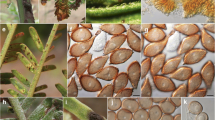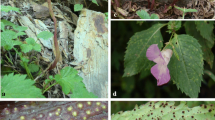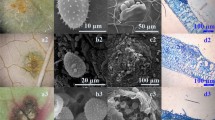Abstract
In 2007, a rust disease of ohia (Metrosideros polymorpha) was found in Japan. We identified this pathogen as Puccinia psidii based on its morphological characters and the internal transcribed spacer (ITS) sequence of the ribosomal DNA. This pathogen was pathogenic on Eucalyptus amplifolia and E. rudis in addition to previously reported host species. This is the first report in Japan of a rust disease on ohia and the occurrence of its causal fungus, P. psidii.



Similar content being viewed by others
References
Alfenas AC, Zauza EAV, Assis TF (2003) First record of Puccinia psidii on Eucalyptus globulus and E. viminalis in Brazil. Australas Plant Pathol 32:325–326
Alfenas AC, Zauza EAV, Wingfield MJ, Roux J, Glen M (2005) Heteropyxis natalensis, a new host of Puccinia psidii rust. Australas Plant Pathol 34:285–286
Altschul SF, Gish W, Miller W, Myers EW, Lipman DJ (1990) Basic local alignment search tool. J Mol Biol 215:403–410
Coutinho TA, Wingfield MJ, Alfenas AC, Crous PW (1998) Eucalyptus rust: a disease with the potential for serious international implications. Plant Dis 82:819–825
Felsenstein J (1985) Confidence limits on phylogenies: an approach using the bootstrap. Evolution 39:783–791
Felsenstein J (1993) PHYLIP: phylogeny inference package, version 3.5. University of Washington, Seattle
Ferreira FA (1981) Ferrugem do eucalipto–Ocorrencia, temperatura para geminação de uredosporos, produção de teliosporos, hospedeiro alternativo e resistência (in Portuguese). Fitopatol Bras 6:603–604
Ferreira FA (1989) Patologia florestal–Principais doenças florestais no Brasil (in Portuguese). Universidade Federal of Viçosa, Brazil
Gallegos HML, Cummins GB (1981) Uredinales (Royas) de México (in Spanish). SARH, Culiacán
Gardes M, Bruns TD (1993) ITS primers with enhanced specificity for basidiomycetes—application to the identification of mycorrhizae and rusts. Mol Ecol 2:113–118
Glen M, Alfenas AC, Zauza EAV, Wingfield MJ, Mohammed C (2007) Puccinia psidii: a threat to the Australian environment and economy—a review. Australas Plant Pathol 36:1–16
Kimura M (1980) A simple method for estimating evolutionary rates of base substitutions through comparative studies of nucleotide sequences. J Mol Evol 16:111–120
Lindquist JC (1982) Royas de la República Argentina y zonas limítrofes (in Spanish). INTA, Buenos Aires
Page RDM (1996) TREEVIEW: an application to display phylogenetic trees on personal computers. Comput Appl Biosci 12:357–358
Percy DM, Garver AM, Wagner WL, James HF, Cunningham CW, Miller SE, Fleischer RC (2008) Progressive island colonization and ancient origin of Hawaiian Metrosideros (Myrtaceae). Proc R Soc B 275:1479–1490
Rayachhetry MB, Van TK, Center TD, Elliott ML (2001) Host range of Puccinia psidii, a potential biocontrol agent of Melaleuca quinquenervia in Florida. Biol Control 22:38–45
Saitou N, Nei M (1987) The neighbor-joining method: a new method for reconstructing phylogenetic trees. Mol Biol Evol 4:406–425
Thompson JD, Higgins DG, Gibson TJ (1994) CLUSTAL_W: improving the sensitivity of progressive multiple sequence alignment through sequence weighting, position-specific gap penalties and weight matrix choice. Nucleic Acids Res 22:4673–4680
Uchida J, Zhong S (2006) First report of a rust disease on Ohia caused by Puccinia psidii in Hawaii. Plant Dis 90:524
Weber RWS, Webster J, Engel G (2003) Phylogenetic analysis of Puccnia distincta and P. lagenophorae, two closely related rust fungi causing epidemics on Asteraceae in Europe. Mycol Res 107:15–24
Acknowledgments
This study was supported in part by a grant-in-aid of the research project for utilizing advanced technologies in agriculture, forestry and fisheries (No. 18037) administered by the Ministry of Agriculture, Forestry and Fisheries in Japan. We are deeply grateful to T. Ozaki, Exotic Plants Inc., for providing plants for inoculations.
Author information
Authors and Affiliations
Corresponding author
Rights and permissions
About this article
Cite this article
Kawanishi, T., Uematsu, S., Kakishima, M. et al. First report of rust disease on ohia and the causal fungus, Puccinia psidii, in Japan. J Gen Plant Pathol 75, 428–431 (2009). https://doi.org/10.1007/s10327-009-0202-0
Received:
Accepted:
Published:
Issue Date:
DOI: https://doi.org/10.1007/s10327-009-0202-0




